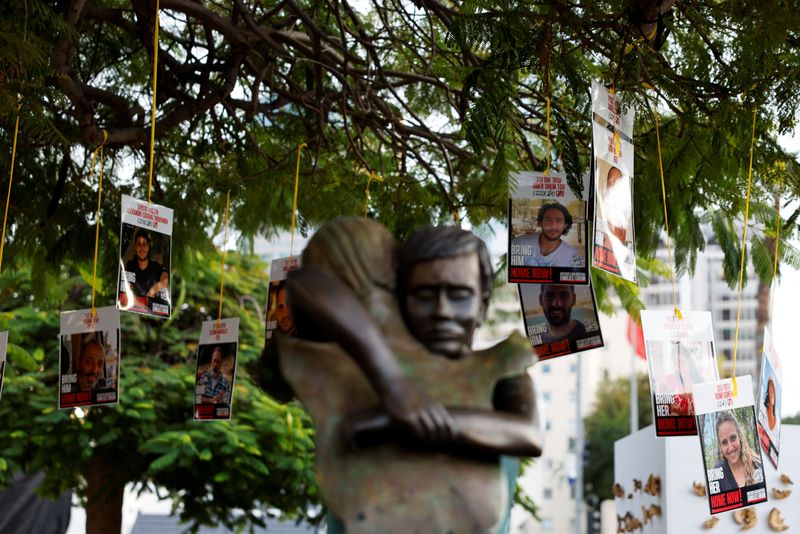
Written by Alexander Cornwell and Nidal Al-Mughrabi
JERUSALEM/CAIRO (Reuters) – Israeli Prime Minister Benjamin Netanyahu's office said on Saturday that the government had approved an agreement with the Islamic Resistance Movement (Hamas) for a ceasefire and the release of hostages in the Gaza Strip, a day before the agreement was scheduled to begin.
In the early hours of Saturday, after a meeting that lasted more than six hours, the government ratified the agreement that could pave the way for an end to the 15-month-old war in the Hamas-controlled Palestinian enclave.
Netanyahu's office said in a brief statement, “The government approved the framework for the return of the hostages. The framework for the release of the hostages will enter into force on Sunday.”
In Gaza, Israeli warplanes have continued their violent attacks since the ceasefire agreement was agreed upon. Medics in Gaza said that an Israeli air strike early on Saturday killed five people in a tent in the Al-Mawasi area, west of Khan Yunis, in the south of the Strip.
This brings to 119 the number of Palestinians who were martyred as a result of Israeli bombing since the agreement was announced on Wednesday.
After approval by the Israeli Cabinet, chief American negotiator Brett McGurk said that the plan is moving forward on the right track.
The ceasefire will go into effect at 0630 GMT on Sunday, the Qatari Foreign Ministry spokesman posted on the X website. The White House expects to release three hostages to Israel in the afternoon through the Red Cross.
“We have included all the details in this agreement,” McGurk told CNN from the White House. “We are very confident…it is ready to go on Sunday.”
Under the agreement, the three-phase ceasefire begins with an initial six-week phase in which hostages held by Hamas are exchanged for prisoners and detainees imprisoned in Israel.
At this stage, 33 of the remaining 98 Israeli hostages are scheduled to be released, including women, children, men over the age of 50, and sick and wounded prisoners. In return, Israel will release approximately 2,000 Palestinians from its prisons.
These include 737 male and female prisoners and teenagers, some of whom are members of Palestinian armed groups convicted of attacks that killed dozens of Israelis, as well as hundreds of Palestinians from Gaza who have been detained since the beginning of the war.
The Israeli Ministry of Justice published its details early on Saturday, along with the ceasefire agreement that stipulated the release of 30 Palestinian prisoners for every hostage on Sunday.
After the hostages are released on Sunday, the agreement calls for the release of four more hostages after seven days, followed by the release of three more hostages every seven days after that, McGurk said.
Hardliners oppose the ceasefire
With the agreement strongly opposed by some hard-liners in the Israeli government, media reports stated that 24 ministers in Netanyahu's coalition government voted in favor of the agreement, while eight opposed it.
Opponents said that the ceasefire agreement represented a surrender to Hamas. National Security Minister Itamar Ben Gvir threatened to resign if approved and urged other ministers to vote against it. But he said he would not topple the government.
His hardline colleague, Finance Minister Bezalel Smotrich, also threatened to resign from the government if it did not return to the war to defeat Hamas after the first six-week phase of the ceasefire.
After a last-minute delay on Thursday that Israel blamed on Hamas, Israel's security cabinet voted on Friday in favor of a ceasefire agreement, a condition before the full government votes.
Israel began its attack on Hamas in Gaza after the movement's fighters stormed Israel on October 7, 2023, killing about 1,200 people and taking 250 hostage, according to Israeli statistics.
The war between Israeli forces and Hamas has destroyed much of the densely urban Gaza Strip, killing more than 46,000 people and displacing most of the Strip's pre-war population of 2.3 million several times, according to Gaza authorities.
If the ceasefire succeeds, it could ease hostilities elsewhere in the Middle East, where fighting has spread to include Iran and its proxies – Lebanese Hezbollah, Yemeni Houthis and armed groups in Iraq – as well as the occupied West Bank.
Civilians in Gaza are facing a humanitarian crisis due to hunger, cold and disease. The ceasefire agreement calls for an increase in aid, and aid trucks from international organizations have lined up on the Gaza border to bring food, fuel, medicine and other vital supplies.
The Palestinian relief agency UNRWA said on Friday that it had 4,000 trucks loaded with aid, half of which was food supplies, ready to enter the coastal strip.

Palestinians waiting for food in the southern Gaza Strip on Friday said they hoped the truce would mean the end of hours waiting in line to fill a single plate.
“I hope it happens so we can cook in our homes and make whatever food we want, without having to go to soup kitchens and exhaust ourselves for three or four hours trying to get (food) — and sometimes not even make it.” Displaced Palestinian Reham Sheikh Al-Eid said: “It is our home.”







